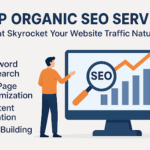Starting a B2B (business-to-business) company often comes with the assumption that you need a large upfront investment, robust infrastructure, and a full-scale team. While that might be true for large corporations, modern entrepreneurs are rewriting the rules. In today’s digital landscape, starting a business—especially a B2B venture—on a small budget is not only possible but increasingly common.
If you’re an aspiring B2B entrepreneur looking to launch without draining your savings, this article will walk you through the budget-friendly blueprint to start small and grow big.
Step 1: Focus on a Niche Market
When you’re starting a business with limited resources, trying to cater to everyone is a costly mistake. Instead, identify a specific niche where your expertise can offer real value. For instance, rather than providing general marketing services, position yourself as a digital marketing expert for local law firms or small healthcare providers.
A tight focus allows you to streamline your offerings, market effectively, and build credibility faster. It also helps you avoid stretching your budget across too many channels or industries.
Step 2: Build a Lean Business Model
In the early stages, your goal should be to keep operations as lean as possible. Consider these budget-friendly strategies:
- Use free or low-cost tools: Tools like Canva (for design), Trello (for task management), and Google Workspace can help you manage your business efficiently.
- Outsource tasks: Instead of hiring full-time employees, use freelancers from platforms like Fiverr or Upwork for specific tasks like graphic design, content writing, or accounting.
- Start from home: Skip renting office space. Remote operations are the new norm, especially for service-based B2B models.
By minimizing your overhead, you can reallocate funds toward growth-driven activities like marketing and lead generation.
Step 3: Establish a Professional Online Presence
In B2B, first impressions matter. Even on a budget, you can create a professional brand that instills confidence:
- Build a website: Use affordable platforms like WordPress or Wix. Your site should clearly explain your services, value proposition, and contact information.
- Secure a domain name: A custom domain name (e.g., www.yourcompany.com) adds legitimacy to your brand.
- Leverage LinkedIn: It’s the go-to platform for B2B networking. Optimize your profile, publish helpful content, and connect with potential clients.
A polished digital footprint is essential for attracting B2B clients who typically do more research before making purchasing decisions.
Step 4: Implement Smart Digital Marketing Strategies
Marketing is crucial when starting a business, but it doesn’t have to be expensive. Here are several digital marketing tips that are cost-effective and deliver results:
- Content Marketing: Start a blog on your website offering advice, tips, or insights related to your niche. This not only helps with SEO but positions you as an expert in your field.
- Email Marketing: Use free email tools like Mailchimp to create newsletters. Email remains one of the most affordable and effective channels for B2B engagement.
- SEO (Search Engine Optimization): Optimize your website content for search engines so your target audience can find you organically. Use tools like Ubersuggest or Google Keyword Planner to identify relevant keywords.
- Social Media Marketing: Focus on platforms that matter in B2B, particularly LinkedIn and Twitter. Share valuable industry content, engage with others, and participate in relevant conversations.
With these digital marketing tips, even a tight budget can yield a steady flow of leads and brand recognition.
Step 5: Leverage Networking and Referrals
Word-of-mouth is powerful in the B2B world. Attend virtual webinars, industry events, and local networking meetups—even if they’re free or low-cost. Introduce yourself, share what you do, and build real connections.
Additionally, don’t hesitate to ask satisfied clients for referrals or testimonials. A single strong referral can open the door to multiple new opportunities without any marketing spend.
Step 6: Offer Scalable Services
When designing your service or product offering, think scalability. This means creating packages or solutions that you can deliver repeatedly without increasing your workload.
For example:
- Instead of custom solutions for each client, offer tiered service packages.
- Create digital products like templates, guides, or toolkits you can sell alongside your services.
- Scalable models allow your business to grow steadily without requiring proportional increases in cost or labor.
Step 7: Track, Measure, and Adjust
One major advantage of starting small is the ability to stay agile. Use analytics tools like Google Analytics, CRM software, and social media insights to track performance. See what’s working and what’s not.
- Is your blog driving traffic?
- Which social platform brings the most engagement?
- Which service package is most popular?
Use this data to refine your offerings and optimize your marketing efforts continuously.
Final Thoughts: Growing Big on a Budget
Starting a business, especially a B2B venture, doesn’t demand a six-figure investment. With strategic planning, digital marketing tips, and the right mindset, you can launch lean, deliver value, and grow sustainably.
The key lies in staying focused, leveraging technology, and consistently providing high-quality solutions to your niche market. Remember: many of today’s leading B2B companies started small—what made them big was not their starting budget, but their execution and persistence.
So go ahead, draft your blueprint, start small—and grow big.



